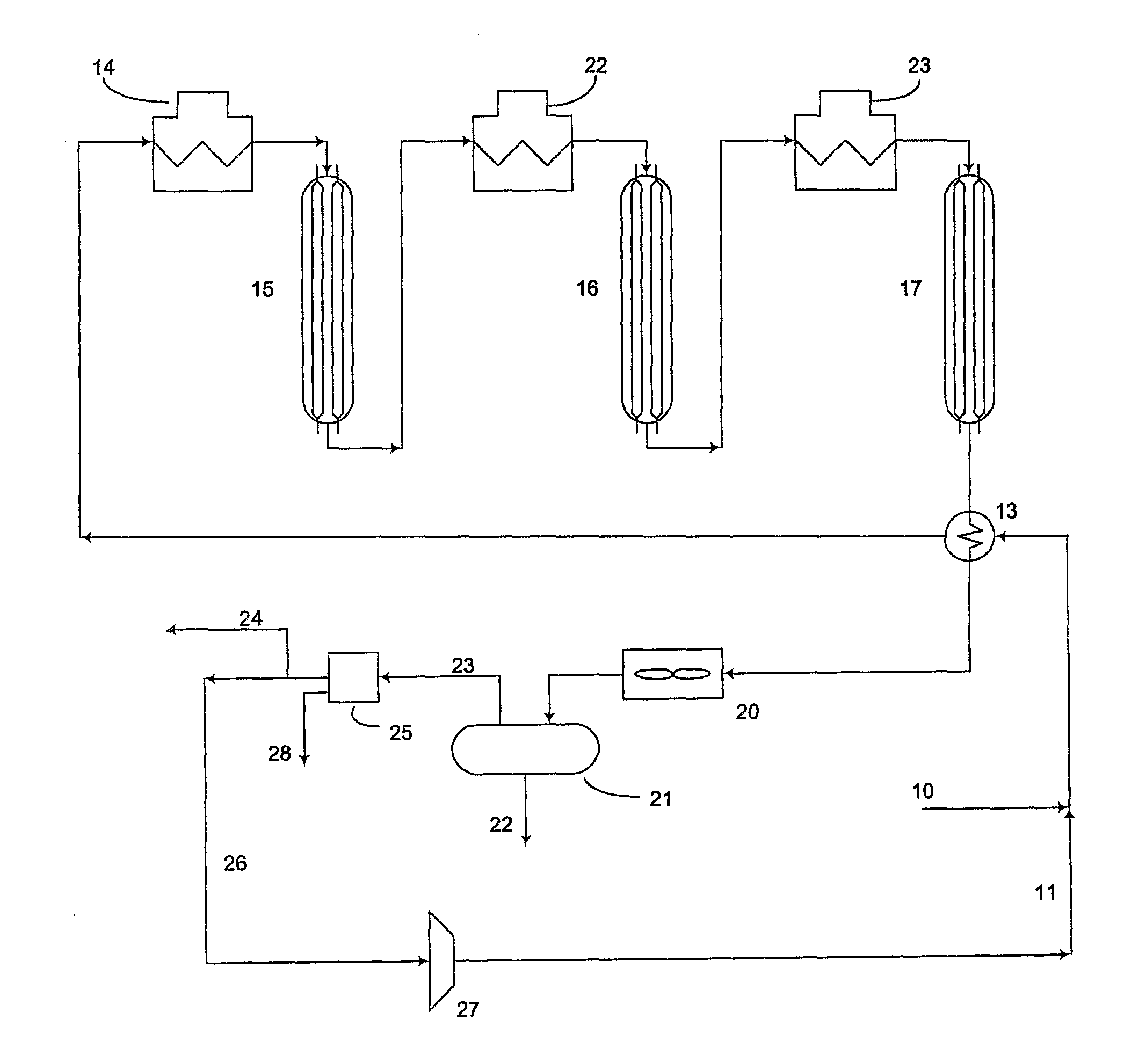Catalytic Reformer Unit and Unit Operation
a technology of catalyst and unit, applied in the direction of hydrocarbon oil cracking, hydrogen separation using solid contact, separation process, etc., can solve the problems of not being able to achieve the desired effect, increasing the feed rate, and reducing the pressure drop of the circui
- Summary
- Abstract
- Description
- Claims
- Application Information
AI Technical Summary
Benefits of technology
Problems solved by technology
Method used
Image
Examples
example 1
[0055]In this example, the refinery stream is at 480 psig with tail gas at 65 psig whereby the pressure swing is 6.18. The feed composition and pressures are typical of refinery processing units such as those found in hydroprocessing or hydrotreating applications. In this example typical hydrocarbons are described by their carbon number i.e. C1=methane, C2=ethane etc. The RCPSA is capable of producing hydrogen at >99% purity and >81% recovery over a range of flow rates. Tables 1a and 1b show the results of computer simulation of the RCPSA and the input and output percentages of the different components for this example. Tables 1a and 1b also show how the hydrogen purity decreases as recovery is increased from 89.7% to 91.7% for a 6 MMSCFD stream at 480 psig and tail gas at 65 psig.
Tables 1a & 1b
Composition (mol %) of Input and Output from RCPSA (67 ft3) in H2 Purification
Feed is at 480 psig, 122 deg F. and Tail Gas at 65 psig. Feed rate is about 6 MMSCFD
[0056]
TABLE 1aHigher puritySt...
example 2
[0058]In this example, the conditions are the same as in Example 1. Table 2a shows conditions utilizing both a co-current and counter-current steps to achieve hydrogen purity >99%. Table 2b shows that the counter-current depressurization step may be eliminated, and a hydrogen purity of 99% can still be maintained. In fact, this shows that by increasing the time of the purge cycle, tP, by the duration removed from the counter-current depressurization step, tCN, that hydrogen recovery can be increased to a level of 88%.
Tables 2a & 2b
Effect of Step Durations on H2 Purity and Recovery from an RCPSA (67 Ft3)
Same Conditions as Table 1. Feed is at 480 psig, 122 deg F. and Tail Gas at 65 psig. Feed Rate is about 6 MMSCFD
[0059]
TABLE 2aWith counter-current depress, Intermediate pressure = 105 psigpurityrecoverytFtCOtCNtPtRP%%sssss98.284.310.2830.050.1670.598.38510.1660.1670.1670.599.98010.0830.250.1670.5
TABLE 2bWithout counter-current depresspurityrecoverytFtCOtCNtPtRP%%sssss97.891.710.33300....
example 3
[0060]This example shows a 10 MMSCFD refinery stream, once again containing typical components, as shown in feed column of Table 3 (e.g. the feed composition contains 74% H2). The stream is at 480 psig with RCPSA tail gas at 65 psig whereby the absolute pressure swing is 6.18. Once again the RCPSA of the present invention is capable of producing hydrogen at >99% purity and >85% recovery from these feed compositions. Tables 3a and 3b show the results of this example.
Tables 3a & 3b
Composition (mol %) of Input and Output from RCPSA (53 Ft3) in H2 Purification. Feed is at 480 psig, 101 deg F. and Tail Gas at 65 psig. Feed Rate is about 10 MMSCFD
[0061]
TABLE 3aHigher purityStep Times in seconds are tF = 0.583, tCO = 0.083, tCN = 0,tP = 0.25, tRP = 0.25H2 at 99.98% purity and 86% recoveryfeedproductTail-GasH274.099.9829.8C114.30.0237.6C25.20.0013.8C32.60.007.4C4+3.90.0011.0H2O2000 vppm0.3 vppm5387 vppmtotal (MMSCFD)10.2206.5143.705480 psig470 psig65 psig
TABLE 3bLower purityStep Times in se...
PUM
| Property | Measurement | Unit |
|---|---|---|
| cycle time | aaaaa | aaaaa |
| swing time | aaaaa | aaaaa |
| boiling | aaaaa | aaaaa |
Abstract
Description
Claims
Application Information
 Login to View More
Login to View More - R&D
- Intellectual Property
- Life Sciences
- Materials
- Tech Scout
- Unparalleled Data Quality
- Higher Quality Content
- 60% Fewer Hallucinations
Browse by: Latest US Patents, China's latest patents, Technical Efficacy Thesaurus, Application Domain, Technology Topic, Popular Technical Reports.
© 2025 PatSnap. All rights reserved.Legal|Privacy policy|Modern Slavery Act Transparency Statement|Sitemap|About US| Contact US: help@patsnap.com

